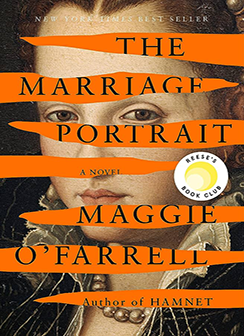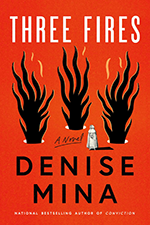 The Marriage Portrait
The Marriage Portrait
by Maggie O'Farrell
GENRE: Historical Fiction, Literary Fiction
Florence, the 1550s. Lucrezia, third daughter of the grand duke, is comfortable with her obscure place in the palazzo: free to wonder at its treasures, observe its clandestine workings, and devote herself to her own artistic pursuits. But when her older sister dies on the eve of her wedding to the ruler of Ferrara, Modena and Reggio, Lucrezia is thrust unwittingly into the limelight: the duke is quick to request her hand in marriage, and her father just as quick to accept on her behalf.
Having barely left girlhood behind, Lucrezia must now enter an unfamiliar court whose customs are opaque and where her arrival is not universally welcomed. Perhaps most mystifying of all is her new husband himself, Alfonso. Is he the playful sophisticate he appeared to be before their wedding, the aesthete happiest in the company of artists and musicians, or the ruthless politician before whom even his formidable sisters seem to tremble?
As Lucrezia sits in constricting finery for a painting intended to preserve her image for centuries to come, one thing becomes worryingly clear. In the court’s eyes, she has one duty: to provide the heir who will shore up the future of the Ferranese dynasty. Until then, for all of her rank and nobility, the new duchess’s future hangs entirely in the balance.
 Author Biography
Author Biography
Maggie O'Farrell was born in Northern Ireland in 1972. Her novels include Hamnet (winner of the National Book Critics Circle Award), After You’d Gone, The Vanishing Act of Esme Lennox, The Hand That First Held Mine (winner of the Costa Novel Award), and Instructions for a Heatwave. She has also written a memoir, I Am, I Am, I Am: Seventeen Brushes with Death. She lives in Edinburgh. - Penguin Random House
Booklist
Following the critically acclaimed Hamnet (2020), O'Farrell creates another mesmerizing portrait of a Renaissance-era woman whose life is shrouded in mystery. "My Last Duchess," Robert Browning's poem about Lucrezia de' Medici (1545--61), gave voice to the longstanding rumors that its subject was murdered by her husband, Alfonso, duke of Ferrara. Was she, and if so, why? A member of Florence's large ruling family, Lucrezia, a restless dreamer who adores animals and creating art, is devastated to learn, at age 12, about plans for her to wed her late sister's fiancé. While Alfonso appears charming, she later witnesses his cruel streak. O'Farrell shines at instilling elegantly described scenes with human feeling, such as Lucrezia's wedding preparations and her sense of inner strength while viewing the sunrise transform the sky at Alfonso's country villa. The author proves equally skilled at evoking suspense. This she accomplishes by alternating between Lucrezia's earlier life and the time when Alfonso brings Lucrezia, his 16-year-old bride, to an isolated stone fortress--perhaps to kill her. The potential motive won't surprise anyone familiar with noblewomen's dynastic roles. Historical-fiction readers will love the cultural details, while Lucrezia's plight speaks to modern themes of gaslighting and women's agency. The leitmotif of "underpainting," hiding truths beneath the surface, echoes throughout this poetically written, multilayered novel.
Kirkus
A teenage Renaissance bride discovers that her husband of scarcely a year intends to murder her. Following up her National Book Critics Circle Award winner Hamnet (2020), inspired by the life of Shakespeare's wife, O'Farrell turns to another woman seen by history only in glimpses. Little is known about Lucrezia de'Medici, married at 15 to the Duke of Ferrara, besides her suspicious death; rumors that she was poisoned prompted Robert Browning's famous poem "My Last Duchess." In contrast to Browning's ever smiling victim, O'Farrell imagines a rebellious spirit less interested in matrimony than in painting the natural world around her. The author develops tension with a split time frame, opening in 1561 in "a wild and lonely place" to which 16-year-old Lucrezia is quite sure Alfonso has brought her to be killed, then circling back to depict her childhood in Florence, including a life-changing encounter with a tiger in her father's private menagerie. From there the two narratives move forward in tandem: We see Lucrezia growing up to be sacrificed to political maneuvering that mandates her marriage to the suave Alfonso and growing aware in Ferrara that her outwardly courteous and kind husband is brutally determined to cement his shaky hold on the dukedom and ferociously intent on making sure she produces an heir. Her only solace comes in painting wild scenes of imaginary creatures, then covering them up with conventional still lifes approved by Alfonso as proper diversions for his duchess. When she meets Jacopo, an apprentice to the painter commissioned to create her portrait, she finds a soul mate who perhaps offers a way out of her imprisoning marriage. Several grim scenes make clear the mortal consequences of any attempt to escape Alfonso's clutches: Will Lucrezia take the risk? The rollbacks to earlier periods spark some impatience as Lucrezia's 1561 dilemma becomes more pressing, but O'Farrell's vivid portrait of a turbulent age and a vibrant heroine mostly compensate for an undue lengthening of suspense as Lucrezia struggles to defy her fate. A compelling portrait of a young woman out of step with her times. Copyright (c) Kirkus Reviews, used with permission.
Publisher's Weekly
This lush, provocative historical from National Book Critics Circle Award winner O'Farrell (Hamnet) follows a young woman who is married off at 15 amid the complex world of 16th-century Italian city-states. O'Farrell bases her heroine, Lucrezia de' Medici, on a real-life figure depicted in Robert Browning's poem "My Last Duchess," who was murdered by her husband. When the reader first meets Lucrezia, she's been married for not quite a year and faces mortal danger in what O'Farrell describes as a "wild and lonely place." The narrative moves back and forth from the nearly deserted fortress where Lucrezia plays a game of cat and mouse with the duke of Ferrara, the husband who might be attempting to kill her, and the events that have brought her here. As a child of a noble family in Florence, she was untamable and passionate about making art. Now, the duke grows increasingly impatient with her as she fails to produce the heir he needs to secure his position. O'Farrell excels at sumptuous set pieces: Lucrezia's encounter with a tiger her father keeps in the basement beneath their palace, the wedding where she is draped and almost swallowed up by her gown, her meetings with the mysterious figures at her new home, particularly her enigmatic husband. By imagining an alternative fate for Lucrezia that deviates from the historical record, the author crafts a captivating portrait of a woman attempting to free herself from a golden cage. Fans of the accomplished Hamnet won't be disappointed by this formidable outing. Agent: Christy Fletcher, Fletcher & Co. (Sept.)
Library Journal
Having won a stack of awards for the Shakespearian meditation Hamnet, O'Farrell moves on to 1550s Florence, where barely pubescent Lucrezia de Medici is content to be the obscure third daughter of the grand duke. Then an older sister dies on the eve of marrying the ruler of Ferrara, Moderna, and Regio, and the groom opts for Lucrezia instead. Lucrezia can't understand her new husband is both a lover of the arts and a fearsome politician, but her job is clear: to produce an heir.
 Anne Boleyn: A King's Obsession
Anne Boleyn: A King's Obsession
by Alison Weir
Born into a noble English family, Anne is barely a teenager when she is sent from her family's Hever Castle to serve at the royal court of the Netherlands. Yet what seems a strategic move on the part of her opportunistic father is actually a chance for the girl to grow and discover herself. There, and later in France, Anne thrives, preferring to absorb the works of progressive writers rather than participate in courtly flirtations. She also begins to understand the inequalities and indignities suffered by her gender.Anne isn't completely inured to the longings of the heart, but her powerful family has ambitious plans for her future that override any wishes of her own. When the King of England himself, Henry VIII, asks Anne to be his mistress, she spurns his advances-reminding him that he is a married man who has already conducted an affair with her sister, Mary. Anne's rejection only intensifies Henry's pursuit, but in the absence of a male heir-and given an aging Queen Katherine-the opportunity to elevate and protect the Boleyn family, and to exact vengeance on her envious detractors, is too tempting for Anne to resist, even as it proves to be her undoing. While history tells of how Anne Boleyn died, this compelling new novel shows just how she lived.
 Matrix
Matrix
by Lauren Groff
Cast out of the royal court by Eleanor of Aquitaine, deemed too coarse and rough-hewn for marriage or courtly life, seventeen-year-old Marie de France is sent to England to be the new prioress of an impoverished abbey, its nuns on the brink of starvation and beset by disease.
At first taken aback by the severity of her new life, Marie finds focus and love in collective life with her singular and mercurial sisters. In this crucible, Marie steadily supplants her desire for family, for her homeland, for the passions of her youth with something new to her: devotion to her sisters, and a conviction in her own divine visions. Marie, born the last in a long line of women warriors and crusaders, is determined to chart a bold new course for the women she now leads and protects. But in a world that is shifting and corroding in frightening ways, one that can never reconcile itself with her existence, will the sheer force of Marie’s vision be bulwark enough?
 Three Fires
Three Fires
by Denise Mina
Girolamo Savonarola was a Dominican friar living in Florence at the end of the fifteenth century. An anti-corruption campaigner, his hellfire preaching increasingly spilled over into tirades against all luxuries that tempted his followers toward sin. These sermons led to the infamous "Bonfire of the Vanities”—a series of fires lit throughout Florence for the incineration of everything from books, extravagant clothing, playing cards, musical instruments, make-up, and mirrors to paintings, tapestries, and sculptures.
Railing against the vice and avarice of the ruling Medici family, he was instrumental in their removal from power—and for a short time became the puritanical leader of the city. After turning his attention to corruption within the Catholic Church, he was first excommunicated and then executed by a combination of hanging and being burned at the stake.
Just as in Rizzio—her latest novel with Pegasus Crime—Denise Mina brings a modern take to this fascinating historical story, drawing parallels between the febrile atmosphere of medieval Florence and the culture wars of the present day. In dramatizing the life and last days of Savonarola, she explores the downfall of the original architect of cancel culture and, in the process, explores the never-ending tensions between wealth, inequality, and freedom of speech that so dominate our modern world.